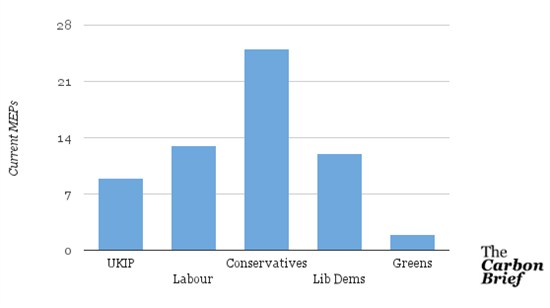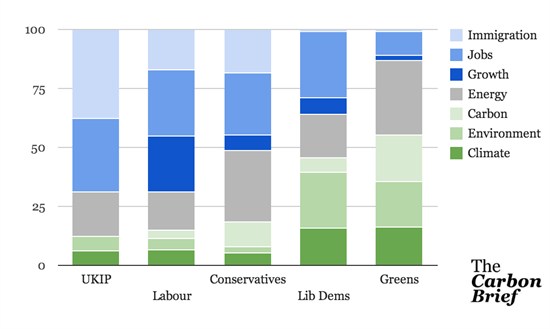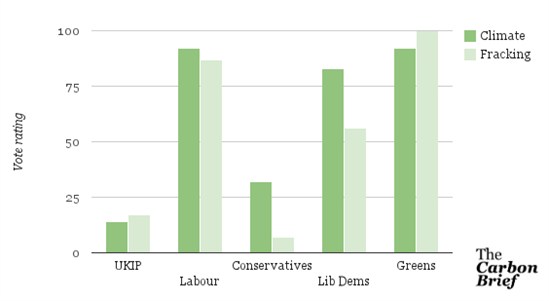Simon Evans
15.05.2014 | 3:05pmBetween 22-25 May voters across the EU have a chance to elect representatives to the European Parliament. In the UK the poll will be held on Thursday 22 May.
Existing EU plans are to spend at least a fifth of its budget on “supporting climate action”. Here’s everything you need to know to cast a vote for, or against stronger EU climate and energy policy.
What can the European Parliament do?
Voters have the chance to elect 73 MEPs to represent the UK’s interests in the 751-strong European Parliament, where the current crop of UK MEPs is split a little differently to our own Parliament in Westminster:

Source: Scoring the European Parliament
These are the first elections since the European Parliament was handed stronger powers by the 2009 Lisbon Treaty. It can now amend, accept or reject all new EU laws – a responsibility shared with member state ministers sitting on the Council of Ministers.
The Parliament has also gained much stronger powers over appointments to the European Commission, the EU’s answer to the mandarins of Whitehall. The main political groupings in the parliament have each nominated a candidate for Commission president, and will vote to approve the final selection.
Polls suggest the balance of power will shift after the May parliamentary elections. Labour and UKIP’s European Parliament political groupings are set to gain influence, while the Conservatives’, Liberal Democrats’ and Greens’ factions are set to lose it.
What do the UK parties say they want from EU climate and energy policy?
Unlike in national elections, none of the UK political parties will be in overall charge in Europe come June. So their manifestos are short on strong commitments.
The Conservative manifesto calls for the EU to focus its efforts on jobs and growth. On climate and energy it says:
“We need to secure energy at an affordable price, cut carbon in order to help prevent dangerous climate change, and reduce our reliance on any one technology or source of supply. Indeed, developments in Ukraine have woken Europe up to the importance of diversifying its energy sources.”
Like the current UK government, in Europe the Conservatives support an EU emissions reduction target of at least 40 per cent by 2030, and oppose binding renewable energy targets.
Their manifesto says emissions should be cut in the cheapest possible way – with renewables, carbon capture and storage and renewables on a “level playing field”. It wants shale gas resources to be “fully developed”.
The Labour manifesto says:
“From getting the European economy working, to tackling climate change, from equal rights to the pound in your pocket, decisions made in the European Parliament matterâ?¦ Continued leadership within Europe to tackle climate change remains vital to protect our environment for generations to come.”
Labour promises to tackle climate change and rising energy bills but does not say how. It does profess support for a single, open European energy market where trading between member states is easier. This could help balance supply and demand with increasing shares of renewables like wind. The Conservatives and Liberal Democrat manifestos back the idea too.
The Liberal Democrat manifesto says the party will push for electricity interconnectors to create a European “super grid” that enables energy trading .
It backs a 50 per cent reduction in EU emissions by 2030 and emphasises the need for Europe to reduce reliance on Russian gas. (The UK doesn’t use Russian gas).
The Lib Dems back EU rules for fuel-efficient cars and energy efficient homes and products. The party wants the European Parliament to stop its monthly commute between Brussels and Strasbourg, which would apparently save 20,000 tonnes of carbon dioxide a year.
The Greens have – as you might expect – a very detailed set of green policies in their manifesto. These include a 90 per cent emissions reduction target for 2030, a 45 per cent renewable energy target rising to 100 per cent in 2050 and a 40 per cent energy saving goal. The Greens want a ban on oil from Canadian tar sands, a complete ban on fracking, and the replacement of the EU’s “failed” emissions trading scheme with legally binding national targets and a much higher price on carbon.
UKIP’s manifesto adds little to the party’s energy policy published last year. It says coal-fired power stations should stay open but should use clean technology to remove sulphur and NOx pollution. (If UK coal plants did this, EU rules would allow them to keep operating.) UKIP opposes spending on renewables.
Priorities
Beyond the specifics it is interesting to look at the priority each party manifesto gives to climate, energy and environment compared to other top political issues. We counted how often these words were used in each manifesto and compared that to mentions of jobs, growth and immigration:

Source: Carbon Brief analysis of 2014 election manifestos.
What have the UK parties actually done?
Analysis of the manifestos may say more about how the parties want to be perceived than how they intend to use their power if elected.
We all know that actions speak louder than words. So what is the record of the UK’s current MEPs?
Scoring the European Parliament, a website backed by Friends of the Earth, has checked MEP’s voting record on topics including climate change and fracking . The website awarded top scores of 100 to MEPs whose votes aligned with its preferences for more ambitious EU climate policy and stricter regulation of fracking for shale gas.
For instance, a European Parliament motion called for a 50 per cent reduction in EU carbon emissions by 2030. Conservative and UKIP MEPs were marked down here because they voted to weaken or block this motion – indeed Conservative MEPs have been consistently less keen on strong climate policy than David Cameron’s government.
This graph shows party-wide average scores handed to MEPs from the UK’s biggest parties in the European Parliament.

Source: Scoring the European Parliament
If you still can’t decide who to vote for, or want to take a wider view, help is at hand. There are two handy websites to help you find the individual MEP, UK party or European Parliament grouping that best represents your views.
And there is no such thing as a wasted vote in European Parliament elections, because MEPs are elected according to proportional representation.
So whatever you think the EU should be doing, this is the chance to have your say.

